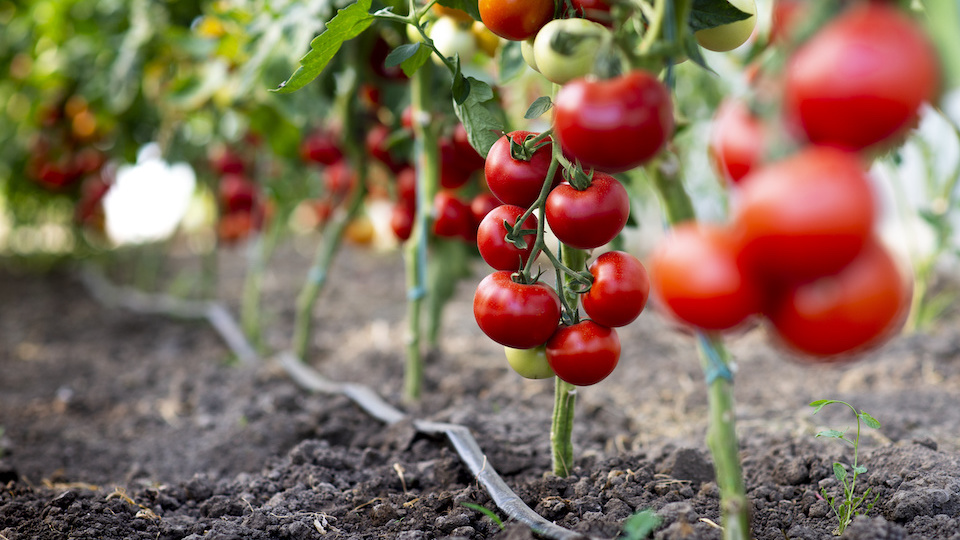There is nothing more delicious than a juicy tomato picked from a homegrown tomato vine. I can remember plucking and eating fresh tomatoes, warm from the summer sun, from my grandparents garden. My grandparents ran a little country market in Iowa and grew some of the biggest and tastiest tomatoes ever. How did they do it? Here are a few of their time-tested tips that they happily shared with anyone who visited their market.
Start early
Start tomato seeds indoors 7-8 weeks before the frost date for your area. This is especially important if you live in a northern climate where the growing season is short. Be sure to harden off your plants before putting them into the ground.
Choose the best location
To perform their best, give tomatoes 6-7 hours of sunlight per day and do not crowd them. Be sure to leave plenty of room between plants to allow for good air circulation, which will help prevent fungal and bacterial issues. Tomatoes love rich soil; if your soil is not rich, be sure to arm yourself with plenty of compost before planting.
Fish heads have what tomatoes love
I know that it may gross you out a bit, but putting a fish head in your tomato planting hole can do wonders for your plants – not only will they be bigger, but the fruit will be tastier. This is because tomatoes love the things that a decaying fish head provides—namely, nitrogen, phosphorus, calcium, and trace minerals. Fish heads decay rapidly, making these nutrients readily available to growing plants. All fish parts are useful, like guts, bones, and even shrimp shells. Fish heads have been used for centuries as quick fertilizer – even the American Indian Squanto taught the Pilgrims how to sow fish and seeds together for a better harvest.
Eggs, anyone?
Eggs provide tomatoes with calcium and sulfur, nutrients that can help your tomato grow huge and prevent blossom end rot. Toss a whole egg into the planting hole or use crushed eggshells.
Feed plants the right stuff at the right time
Tomato plants are super heavy feeders and require a constant supply of high-quality fertilizer throughout the growing season. Once a week, when tomatoes are young, provide a chicken manure compost tea. This tea encourages the development of strong roots and stable stems. Once your plant is blooming, stop nitrogen and provide more calcium. You can do this by crushing up some eggshells and placing them in the dirt around your tomato plant. Water well and watch your plant produce big and beautiful fruit.
Get rid of suckers
Tomatoes are not a super time-consuming plant to grow, but you do have to stay on top of the pruning if you want them to do their best. Make sure that you are pruning suckers – or side shoots that grow out of the joint where a branch meets the main stem. When you see them, pick or snip them off to encourage the plant’s energy to focus on the main plant and producing big fruit. If you leave the suckers on, you may get more fruit, but it will be smaller and less tasty. Pruning is only needed with indeterminate tomatoes because determinate types will only produce what the plant can support.
Your tomato plants need support
Yes, you can encourage your tomato plant to grow by talking nicely to it, but there is another type of support that is needed, a sturdy trellis. There are all sorts of ways to provide this support, such as cages and row supports. The most important thing is that you pick the type of support that works best for your garden set-up and tomato plants. Failure to provide support results in tomatoes hanging on the ground, which can lead to issues with moisture and disease.
Water deeply 3x per week
Deep watering is always better than shallow watering. Do this a few times a week in the heat of summer for best results. Water the soil directly, being careful not to get water on the leaves. This encourages bacterial growth. Soaker hoses work great for tomatoes because they deliver the water where it is needed without compromising the foliage. Being consistent with watering can make a tremendous difference in your tomato production. Most issues, such as cracks, splits, stunted fruit size, and root rot stem from poor watering habits
Know when to pick
Tomatoes that you purchase at the grocery store are often picked from the vine before they are ripe and transported hundreds or even thousands of miles before they arrive in your salad. The tastiest tomatoes are the ones that are allowed to ripen on the vine. Ripe tomatoes are firm and very red – when they reach this stage, they are ready to be harvested. Do not store ripe tomatoes in the refrigerator because they will quickly lose their color, taste, and texture. Place tomatoes that fall before they are fully ripe in a paper bag and store them in a coo, dry location until they are ready.
Happy growing!
-Susan Patterson, CBHC and Master Gardener




